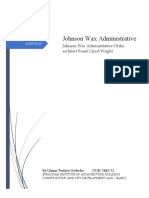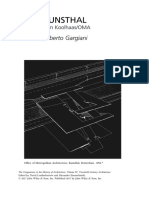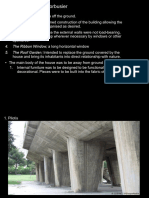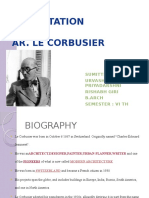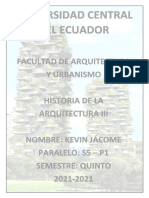High Court's Architectural Design
High Court's Architectural Design
Uploaded by
Amitesh VermaCopyright:
Available Formats
High Court's Architectural Design
High Court's Architectural Design
Uploaded by
Amitesh VermaOriginal Title
Copyright
Available Formats
Share this document
Did you find this document useful?
Is this content inappropriate?
Copyright:
Available Formats
High Court's Architectural Design
High Court's Architectural Design
Uploaded by
Amitesh VermaCopyright:
Available Formats
High Court's Architectural Design Le Corbusier once described the complex of which the high court formed a part
as "a great architectural venture using very poor materials and a labor force quite unused to modern building techniques, with the tremendous obstacle of the sun and the necessity of satisfying Indian ideas and needs, rather than to impose Western ethics and aesthetics. The problem is accentuated by the ruling factor of the sun, under which a new Indian way of life must be created. The sun is so violent that until now the habits of siesta and laziness were inevitable, in native architectural conditions which allowed no work whatsoever at certain hours and seasons. The rainy season also has its problems."It was hoped that the buildings could be so designed as to permit the government to function throughout the year at Chandigarh, omitting the annual summer migration to the hill s customary in former years. It would be important that the building furnish protection from the
sun and also the monsoon rains. An effort to shade the entire structure has resulted in the use of a double roof, the upper roof cantilevered out over the office block in the manner of a parasol shading the lower roof and also providing a trough from which monsoon rain water spills through heavy spouts at either end, falling sixty feet to channels connected with the reflecting pools. The space between the two roofs is left open to enable currents of air to move between the flat roof of the office block and the underside of the parasol roof which slopes toward the center in the form of a row of arches. The program of the high court building specified provision for eight law courts and a high court, together with necessary office space. In plan the building took the form of an abbreviated L-shape with the long facade facing the capitol plaza to contain the courtrooms and the small rear extension to accommodate offices. Essentially, the building is a rectilinear frame within which interior functions are defined, the eight courtrooms identically expressed
on the main facade and separated from the larger high court by a monumental columned entrance rising the height of the building. Early sketches for the building show a multiplicity of arch forms on the facades, with the main courtroom floor raised above ground level on pilots and approached by a ramp. In the final version, however, the building rises directly from the earth, the main facade defined by a fullheight concrete brise-soleil and the arch forms restricted to the underside of the parasol roof. The design modifications also appear to have involved space reductions, and the final plan eliminated a row of antechambers (sales de deliberation) behind the courtrooms, together with a number of staircases high court, communicating it evolved directly toward with an small upstairs
offices. As Le Corbusier developed the design for the expression increasingly massive, plastic, and abstract. The perhaps excessive horizontality of earlier schemes was countered by an increase in vertical dimension, while what were originally narrow columns in the main
entrance hall became three massive flattened piers leading inward. It is the visual drama of these piers rising sixty feet from the ground to meet the heavy outward thrust of the roof which creates the focal emphasis of the present plan. What in early drawings was expressed as a lightly framed pavilion, horizontal in dimension, has become a vertically expanding space in which the void is defined and dramatized by strongly assertive sculptural elements. Within the simple and rather static outer frame, the building embodies a constantly active balance of tensions. On the main facade the deep (4 ft. 7 in.), fixed concrete brise-soleil gives a strong and scale less pattern to the building, and only human beings and the unobtrusive courtroom doors can be used as visual keys for reading the dimensions of the surface. Commented the architect, "here the brise-soleils take the place of the weather-drips on a classical facade, but they cover not only the windows but the entire facade, and influence the whole structure."It is the concrete screen which gives the main facade its
overall unity, so that it is perceived not as an assemblage of floor levels and courtroom chambers, but as a single entity of plastically interwoven elements, in which the horizontal ground line, repeated in the two roof levels, is countered buy the powerful upward thrust of the entrance piers and the pillars between the courtrooms, whose vertical line is echoed in the roof supports. Behind the brise-soleil, the windows of the courtrooms are of fixed glass, but between are narrow vertical spaces containing shutters which open and close on hinges, a ventilating devise which Le Corbusier began developing for the Mediterranean coast. Once while visiting the high court with an acquaintance, the architect indicated the courtroom wall and said, "You see, it is all glass. But the sun will never be dangerous. He will not be the enemy but the friendnot the enemy but the friend." It should perhaps be noted that the orientation of the high court is such that the main facade faces northwest, and thus does not receive direct sunlight
until late in the day, long after the hours during which court is normally in session. The light which enters the courtrooms during the morning and early afternoon is essentially reflected glare which is diffused by the sun breakers and also by curtains within the chambers. Even so, some judges have moved their benches to avoid facing the light. On the rear facade of the building, which houses most of the offices and has a south-eastern exposure, the brisesoleil is put to a severe functional test. When the high court was first completed, the gunnite-coated entrance piers were painted white, producing a surface closely harmonizing with the concrete and reminding some visitors of the pristine clarity of Greek temple columns. Eventually, however, Le Corbusier became dissatisfied with the color of the entrance portico and after much consideration produced in 1958 a new scheme for painting the columns and portico walls in bright contrasting colors. The inside wall to the let of the piers was to be black, with the adjacent pillar painted green. The center pier
would be yellow, the right-hand pillar red, and the remaining portico wall primary blue. The execution of this design was delayed, partly because a latex-base paint would be required, and as this had not been included in the original cost of the building, funds had to be specially appropriated. Moreover, the project office may have been slow in executing the scheme because, except for Le Corbusier, no one felt very favorably about the change. Finally, in July, 1962, the job was completed. The decision to paint such a large and important area of the high court was unquestionably a major one, for it has substantially altered the appearance of the building. Part of the difficultly in accepting the new version of the high court derives from the length of time during which people had become accustomed to the old appearance and had come to associate the white piers with the symbolic dignity of the building, for to some the alteration in the high court is as startling as if they were to behold the Parthenon restored to its original polychrome. Although the new
color scheme may seem a bit overpowering at close range, from a distance its vibrancy seems not inappropriate to the scale of the complex, and it has undeniably augmented the overall visual impact of the court. It must be remembered that in the composition of the capitol complex, the high court alone must balance one side of the grouping, opposing the great mass of the secretariat combined with the sculptural variety of the assembly. As the originally self-contained form of the assembly evolved a more assertive plasticity. Le Corbusier may have felt the need to give the relatively small and pristine high court an emphatic color scheme to enhance its visual weight across the monumental plaza. This is accomplished successfully, but at the cost of altering somewhat the monochromatic harmony which previously united all of the capital buildings. Because the exposed concrete surfaces inside the courtrooms produced a problem in acoustics, it was found necessary to introduce a more soundabsorptive surface and the solution determined by Le
Corbusier was the creation of a series of large tapestries to cover the interior walls behind the judges' benches. The design of these tapestries was composed by Le Corbusier of independent elements based on the Modulor in such a manner that although the design were done in Paris, precise directions for their execution could be telegraphed to India. These directions specified the exact dimensions of the separate elements and included a color chart based on samples obtained in Chandigarh , together with a chart showing the final assembled pattern. The weaving was mean, to be done in villages and in prisons, preferably with one village undertaking to execute a whole tapestry. This was to prove impractical, however, and eventually the entire 650 meters of tapestry were executed in five months by a Kashmir firm. Although the tapestries were reported to "have provoked the delighted acquiescence of Mr. Nehru and the Governor of Punjab as well as Chief Judge", it was perhaps inevitable that the designs, large in
scale and composed of unfamiliar abstract elements would arouse opposition from some of the judges who declared them "an outrage to the dignity of justice."One judge is said to have implored Thapar, "For God's sake, burn them or do something."Two or three of the tapestries were removed, and it appeared for a while that they might be eliminated altogether, but Le Corbusier, according to one of his colleagues, was able to appeal to "the highest authority", which was assumed to be Nehru, and subsequently, the High Court people showed much tolerance in accepting the tapestries." Whatever criticisms may be made of the high court, there is no doubt about its visual impressiveness. Albert Mayer, visiting Chandigarh in 1958, wrote, "All this, the great hall, the great ramp, the huge columns, produce a noble and powerful effect, almost a primordial effect."In his opinion, however, the building did not work functionally, and its "effect are gained by padding the structure so to speak."To Mayer, the high court was "really a great
evocative work of sculpture, not in fact architecture." Although it seems hardly reasonable to deny the work of Le Corbusier the title of architecture, there is no question that its primary effectiveness lies in its poetic, sculptural aspects. Recalling I' United' Habitation. Maxwell Fry once said, "It was the miracle of Marseilles to find how the building, standing there among its trees, sung like a humming top, monumental but vibrating. And so again will be his high court at Chandigarh a monument of the plain, vibrating in the Indian sunlight, organic because it is a living organ of though and emotion, but fixed there crystalline, crystal clear, in an idea of life established until ruin finally overtakes it as ruin will overtake the very hills against which it now stands silhouetted."
You might also like
- Marriott VRIO AnalysisDocument4 pagesMarriott VRIO Analysisj.xiao15680No ratings yet
- Advertisement in The Philippines: History, Evolution, and The Filipino ConsumerDocument12 pagesAdvertisement in The Philippines: History, Evolution, and The Filipino ConsumerZeus LegaspiNo ratings yet
- High Court Chandigarh2Document26 pagesHigh Court Chandigarh2vporecha100% (6)
- Sanskar Kendra Case StudyDocument17 pagesSanskar Kendra Case StudyvaishaliNo ratings yet
- Case StudyDocument34 pagesCase Studymarksman_para90% (10)
- Johnson Wax Administrative of Frank Lloyd WrightDocument4 pagesJohnson Wax Administrative of Frank Lloyd WrightGirum TesfayeNo ratings yet
- "Le Corbusier's Centrosoyuz in Moscow," by Jean-Louis CohenDocument10 pages"Le Corbusier's Centrosoyuz in Moscow," by Jean-Louis CohenRoss WolfeNo ratings yet
- Modern Architecture and Climate: Design before Air ConditioningFrom EverandModern Architecture and Climate: Design before Air ConditioningRating: 4 out of 5 stars4/5 (1)
- Kunsthal: Rem Koolhaas/omaDocument8 pagesKunsthal: Rem Koolhaas/omaEduardo Cesar GentileNo ratings yet
- A Criticial Analysis of Tatara Bridge, JapanDocument10 pagesA Criticial Analysis of Tatara Bridge, JapanYati Aggarwal100% (1)
- High Court ChandighDocument11 pagesHigh Court ChandighAr Apurva SharmaNo ratings yet
- HOA Assignment GRP 6Document25 pagesHOA Assignment GRP 6GayathriNo ratings yet
- Le Corbusier Case StudyDocument15 pagesLe Corbusier Case StudyVrudansh MohiteNo ratings yet
- Le CorbusierDocument5 pagesLe Corbusierheey.hallo.holaNo ratings yet
- Modern Architecture QuizDocument5 pagesModern Architecture QuizConstantiniu IoanaNo ratings yet
- LE CORBUSIERDocument4 pagesLE CORBUSIERlalitkumar060400No ratings yet
- Module 1 - 863463150Document112 pagesModule 1 - 863463150SACHIDANANDA SNo ratings yet
- Marsh Ellen Ar10342 PDFDocument1 pageMarsh Ellen Ar10342 PDFEllie MarshNo ratings yet
- Chandigarh Urban Planner & Ar - Le CorbusierDocument18 pagesChandigarh Urban Planner & Ar - Le CorbusierLidhya Teslin Joseph100% (1)
- The Five Principles of Le Corbusier and Monumentality Concept of Louis KahnDocument9 pagesThe Five Principles of Le Corbusier and Monumentality Concept of Louis Kahngarima0303100% (4)
- Case Study2-Sanskar KalakendraDocument8 pagesCase Study2-Sanskar KalakendraVed BhandwalkarNo ratings yet
- Villa Stein-De-Monzie by Le Corbusier (1926-1928) : Conservation Strategies Between Research and EducationDocument7 pagesVilla Stein-De-Monzie by Le Corbusier (1926-1928) : Conservation Strategies Between Research and EducationOscar EustáchioNo ratings yet
- Le Corbusier: ArchitectDocument30 pagesLe Corbusier: ArchitectDileep GeddamNo ratings yet
- Le Corb - 1Document19 pagesLe Corb - 1Aditya Dinesh BhagatNo ratings yet
- Capitol ComplexDocument9 pagesCapitol ComplexDeepika Reddy100% (1)
- 09 Functionalism in Modern ArchitectureDocument13 pages09 Functionalism in Modern ArchitectureYukta100% (1)
- Carpenter Center For The Visual Arts - Harvard University - Le CorbusierDocument21 pagesCarpenter Center For The Visual Arts - Harvard University - Le CorbusierAparna KulshresthaNo ratings yet
- Presentation ON Ar. Le Corbusier: Sumitted by Urvashi Priyadarshni Rishabh Giri B.Arch Semester: Vi THDocument35 pagesPresentation ON Ar. Le Corbusier: Sumitted by Urvashi Priyadarshni Rishabh Giri B.Arch Semester: Vi THManish SinghNo ratings yet
- Late Works of Le CorbDocument16 pagesLate Works of Le CorbKeithy GandhiNo ratings yet
- CONTEMPORARYDocument10 pagesCONTEMPORARYTRILZ ARIS MILO ARREOLANo ratings yet
- Contemporary ArchitectureDocument10 pagesContemporary ArchitectureTRILZ ARIS MILO ARREOLANo ratings yet
- Le Corbusier and The Unite D-HabitationDocument8 pagesLe Corbusier and The Unite D-HabitationAnonymous Psi9GaNo ratings yet
- Case Studies MuseumDocument12 pagesCase Studies MuseumSunny Sharma100% (1)
- 5 Points Le CorbusierDocument2 pages5 Points Le CorbusierJosh HinnebuschNo ratings yet
- TEXTO 3 Le Corbusiers Five Points of Modern Architecture - Calle AyelenDocument8 pagesTEXTO 3 Le Corbusiers Five Points of Modern Architecture - Calle AyelenAyelen CalleNo ratings yet
- HoA3 (3.1 Le Corbusier - Contribution To Architecture)Document12 pagesHoA3 (3.1 Le Corbusier - Contribution To Architecture)susri mallipudiNo ratings yet
- Kala Kendra, AhmedabadDocument8 pagesKala Kendra, Ahmedabadrashid sikandar100% (2)
- Frank o GehryDocument32 pagesFrank o GehryGreeshma GowdaNo ratings yet
- EPM Library AnalysisDocument10 pagesEPM Library AnalysisScribdTranslationsNo ratings yet
- Characteristics and Theoretical Framework of ModernismDocument4 pagesCharacteristics and Theoretical Framework of ModernismMahbuba Moumi100% (1)
- Functionalism in Modern Architecture: Le CorbusierDocument13 pagesFunctionalism in Modern Architecture: Le CorbusierAlaa NoutiNo ratings yet
- Hong Kong and Shanghai Bank HeadquartersDocument15 pagesHong Kong and Shanghai Bank HeadquartersMuhammad Barry Budi PrimaNo ratings yet
- Iversity First ExamDocument4 pagesIversity First ExamPratishtha GargNo ratings yet
- NGUY KHANH PHUONG-31231023475 HANDOUTDocument11 pagesNGUY KHANH PHUONG-31231023475 HANDOUTLương Đình LongNo ratings yet
- Villa Savoye: Architecture & Town Planning Assignment#2Document8 pagesVilla Savoye: Architecture & Town Planning Assignment#2Hassan Ali SadiqNo ratings yet
- Jean-Louis Cohen - Le Corbusier's Tsentrosoiuz in Moscow (Summer 2008)Document10 pagesJean-Louis Cohen - Le Corbusier's Tsentrosoiuz in Moscow (Summer 2008)Javier PerezNo ratings yet
- Ensayo - Jácome KevinDocument3 pagesEnsayo - Jácome KevinKevin JacomeNo ratings yet
- Architect Le CorbusierDocument20 pagesArchitect Le Corbusiernaveenarora298040No ratings yet
- Precedent Case StudyDocument8 pagesPrecedent Case StudyPriti Shukla0% (1)
- The Pantheon by David MooreDocument8 pagesThe Pantheon by David MooreTauqeer BhatNo ratings yet
- Guggenheim MuseumDocument32 pagesGuggenheim MuseumMay SayrafiNo ratings yet
- Alternatives To International Style of ArchitectureDocument54 pagesAlternatives To International Style of ArchitectureShubham GoelNo ratings yet
- Le Corb 5 PointsDocument3 pagesLe Corb 5 PointsSavar SuriNo ratings yet
- Frank Owen GehryDocument23 pagesFrank Owen GehryrishavNo ratings yet
- Crow Hall 2Document9 pagesCrow Hall 2Rahma MgNo ratings yet
- History 3 FFFFFFFFFFDocument16 pagesHistory 3 FFFFFFFFFFnadatamer921No ratings yet
- Guggenheim BilbaoDocument11 pagesGuggenheim BilbaoSandra SamirNo ratings yet
- History of Arch-Le CorbusierDocument40 pagesHistory of Arch-Le Corbusiersmsweetmadhavi80% (10)
- Don't Build, Rebuild: The Case for Imaginative Reuse in ArchitectureFrom EverandDon't Build, Rebuild: The Case for Imaginative Reuse in ArchitectureNo ratings yet
- Window Shopping with Helen Keller: Architecture and Disability in Modern CultureFrom EverandWindow Shopping with Helen Keller: Architecture and Disability in Modern CultureNo ratings yet
- ED105 ReviewerDocument10 pagesED105 Revieweraizabhelle2003No ratings yet
- ModuleDocument3 pagesModuleParulNo ratings yet
- Quectel OpenCPU Quick Start Application Note V1.1Document34 pagesQuectel OpenCPU Quick Start Application Note V1.1jijoNo ratings yet
- Grade 10 Project Questions - 240426 - 083026Document5 pagesGrade 10 Project Questions - 240426 - 083026tori.vega298No ratings yet
- Pages From RFP - DPR - Resort in Sohra - MeghalayaDocument2 pagesPages From RFP - DPR - Resort in Sohra - MeghalayaAnkit kumarNo ratings yet
- Bulletin 2018-19 Grad EngineeringDocument109 pagesBulletin 2018-19 Grad EngineeringLuciana Mendoza FlorezNo ratings yet
- Realizing What Teaching Internship Is All About: Learning Task 1Document19 pagesRealizing What Teaching Internship Is All About: Learning Task 1jenelle marianoNo ratings yet
- Techno Commercial PDFDocument9 pagesTechno Commercial PDFJo PachaNo ratings yet
- Pandora Box WIFI 8000 GamelistDocument317 pagesPandora Box WIFI 8000 Gamelistfrancesco.scavello23No ratings yet
- Young's MMPL Pricelist 2022Document6 pagesYoung's MMPL Pricelist 2022Newstar EaNo ratings yet
- Leadership Feedback Assessment Survey ReportDocument6 pagesLeadership Feedback Assessment Survey ReportRaydene Grace FloresNo ratings yet
- Preventing Violent Behavior and Understanding Aggression in ChildrenDocument5 pagesPreventing Violent Behavior and Understanding Aggression in Childrenninja 2 niguhit remNo ratings yet
- Saudi Energy Conservation Code - Low Rise (SBC 602) Update ENDocument2 pagesSaudi Energy Conservation Code - Low Rise (SBC 602) Update ENSybrenBoomsmaNo ratings yet
- 01-SF Salaries Exercise CSVDocument3 pages01-SF Salaries Exercise CSVMeenakshi KandulvaNo ratings yet
- Cadences PopDocument1 pageCadences PopIvan RéchardNo ratings yet
- 2006 Design Data Handbook PDFDocument284 pages2006 Design Data Handbook PDFRam CsnNo ratings yet
- Towards A General Theory of Translation Action. Skopos Theory Explained. Katharina Reiss and Hans J. Vermeer. Translated by Christiane NordDocument240 pagesTowards A General Theory of Translation Action. Skopos Theory Explained. Katharina Reiss and Hans J. Vermeer. Translated by Christiane NordHadjer100% (2)
- Domino AdministratorDocument61 pagesDomino AdministratorPradeep MoreNo ratings yet
- Descriptive Text (Describing Things and Places)Document12 pagesDescriptive Text (Describing Things and Places)DindaCahyaKurniaPutriNo ratings yet
- Prolonged Proestrus Bleeding and Medical Treatment in An English Pointer DogDocument3 pagesProlonged Proestrus Bleeding and Medical Treatment in An English Pointer DogMohanNo ratings yet
- Explore The Concepts of Expectation, Standard Deviation, Variance, and CovarianceDocument33 pagesExplore The Concepts of Expectation, Standard Deviation, Variance, and CovarianceDhexter VillaNo ratings yet
- Drug ExpiryDocument3 pagesDrug Expiryhap hazardNo ratings yet
- Catalogue Indirect MeteringDocument4 pagesCatalogue Indirect MeteringCata ComanNo ratings yet
- CFE Prelims 2nd SemDocument10 pagesCFE Prelims 2nd Semrose llarNo ratings yet
- Eduart Zimer - Trying To Get The Names Right (Part 2) (2011)Document6 pagesEduart Zimer - Trying To Get The Names Right (Part 2) (2011)eduartzimerNo ratings yet
- And Etiology of Dental CariesDocument29 pagesAnd Etiology of Dental CariesJu JuNo ratings yet






